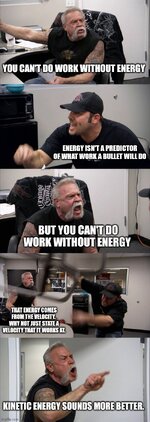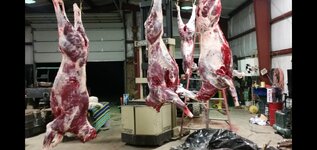Navigation
Install the app
How to install the app on iOS
Follow along with the video below to see how to install our site as a web app on your home screen.
Note: This feature may not be available in some browsers.
More options
Style variation
You are using an out of date browser. It may not display this or other websites correctly.
You should upgrade or use an alternative browser.
You should upgrade or use an alternative browser.
Does Energy have the potential to affect terminal performance?
- Thread starter 10E
- Start date
Billy Goat
“MOMMY”
I have posted this elsewhere but have been interested in terminal ballistics and how the variables play together. In general it is a complex topic how a live target interacts to a wound but the physics and fluid dynamics are pretty well understood about how things work. Since asked about energy and how the science works…
The wound volume potential is directly proportional to the kimetic energy of the bullet. The energy is determined by mass x v^2. A bigger wound may or may not cause something to die more quickly. A lot of guys say energy doesn't matter at all, but a better statement to me is once you have enough in right spot more does not matter. As an aside, A pet peeve of mine is the “arrow example” of why energy doesn’t matter. A sharp broadhead tipped arrow going 100 fps kills quite well. If using arrow as an analogy I guess velocity doesn’t matter either..
Penetration is proportional to velocity x sectional density. This is terminal sectional density NOT starting sectional density. For ex, monos penetrate deeply because they have higher terminal sectional density and tend to lose velocity at slower rate due to less frontal area i.e. through less expanded diameter, space in between petals, or blowing off petals entirely. This is also why something like a nosler partition will penetrate more deeply than equivilant starting weight swift aframe. Penetration is important as you need enough to at least damage vital stuff.
Energy is a big factor in termporary cavity. Temporary cavity is called temporary not because of the damage it causes but because it happens in a millisecond in the wake of the bullet as material is blasted away from the passing of the bullet. It can be many times larger than bullet diameter and some tissue is simply blasted away and gone, some torn by stretching, and some snaps back. The wider the cavity is the more tearing happens vs stretching. I have seen various velocity levels people think this starts happening but nothing conclusive in real literature. However increased wounding almost always happens with high velocity/energy hunting cartridges and not so much in say defensive handgun rounds.
The diameter of the temporary cavity is proportional to the rate of energy transfer from bullet to animal at any given instance during penetration. The rate of energy transfer is basically drag which is proportional to frontal area and v^2. This is why smaller faster bullets can at times make wider wounds than slower wider bullets. This is also why you tend to see the “football” shape wounds in gel/game
Bullet fragmentation is a damage multiplier for temporary cavity. Tissues that only stretch will tear to shreds when have holes from fragmentation. In this regard high velocity can show much bigger diameter wounds than larger diameter slower bullets since not only promotes higher drag/energy transfer but also bullet fragmentation and expansion. While fragmentation may be good for increasing wounding it can also be bad if decreased penetration (ie your projectile loses too much terminal sectional density) to the point the significant wounding does not happen in vital area
The final wound cavity is the size of whatever is destroyed by the bullet directly crushing it or tissue damage as a result of the temporary cavity. One thing a lot of people are not aware of is that much like temporary cavity, a slow bullet may push its way through tissue and once passes through tissue snaps back to smaller diameter wound channel or pushes organs out of way vs damaging.
Bullet constuction predominately determines how the energy is transefered to the target to do the wounding. Contruction impacts terminal shape of the bullet which plays into penetration/wounding. Fragmenting designs may have wide shallow wounds. Flat fmj may have long narrow wounds. Lot of stuff in between. All a tradeoff
So - think how these apply to your favorite cartridge, bullet, the shots you take, etc… and see if it makes sense. As you can see there is a complex system of events going on a bullet traverses the target, changes shape, and mass. You can sort of tweak how prefer this to happen based on your preference of terimal performance
Lo
The wound volume potential is directly proportional to the kimetic energy of the bullet. The energy is determined by mass x v^2. A bigger wound may or may not cause something to die more quickly. A lot of guys say energy doesn't matter at all, but a better statement to me is once you have enough in right spot more does not matter. As an aside, A pet peeve of mine is the “arrow example” of why energy doesn’t matter. A sharp broadhead tipped arrow going 100 fps kills quite well. If using arrow as an analogy I guess velocity doesn’t matter either..
Penetration is proportional to velocity x sectional density. This is terminal sectional density NOT starting sectional density. For ex, monos penetrate deeply because they have higher terminal sectional density and tend to lose velocity at slower rate due to less frontal area i.e. through less expanded diameter, space in between petals, or blowing off petals entirely. This is also why something like a nosler partition will penetrate more deeply than equivilant starting weight swift aframe. Penetration is important as you need enough to at least damage vital stuff.
Energy is a big factor in termporary cavity. Temporary cavity is called temporary not because of the damage it causes but because it happens in a millisecond in the wake of the bullet as material is blasted away from the passing of the bullet. It can be many times larger than bullet diameter and some tissue is simply blasted away and gone, some torn by stretching, and some snaps back. The wider the cavity is the more tearing happens vs stretching. I have seen various velocity levels people think this starts happening but nothing conclusive in real literature. However increased wounding almost always happens with high velocity/energy hunting cartridges and not so much in say defensive handgun rounds.
The diameter of the temporary cavity is proportional to the rate of energy transfer from bullet to animal at any given instance during penetration. The rate of energy transfer is basically drag which is proportional to frontal area and v^2. This is why smaller faster bullets can at times make wider wounds than slower wider bullets. This is also why you tend to see the “football” shape wounds in gel/game
Bullet fragmentation is a damage multiplier for temporary cavity. Tissues that only stretch will tear to shreds when have holes from fragmentation. In this regard high velocity can show much bigger diameter wounds than larger diameter slower bullets since not only promotes higher drag/energy transfer but also bullet fragmentation and expansion. While fragmentation may be good for increasing wounding it can also be bad if decreased penetration (ie your projectile loses too much terminal sectional density) to the point the significant wounding does not happen in vital area
The final wound cavity is the size of whatever is destroyed by the bullet directly crushing it or tissue damage as a result of the temporary cavity. One thing a lot of people are not aware of is that much like temporary cavity, a slow bullet may push its way through tissue and once passes through tissue snaps back to smaller diameter wound channel or pushes organs out of way vs damaging.
Bullet constuction predominately determines how the energy is transefered to the target to do the wounding. Contruction impacts terminal shape of the bullet which plays into penetration/wounding. Fragmenting designs may have wide shallow wounds. Flat fmj may have long narrow wounds. Lot of stuff in between. All a tradeoff
So - think how these apply to your favorite cartridge, bullet, the shots you take, etc… and see if it makes sense. As you can see there is a complex system of events going on a bullet traverses the target, changes shape, and mass. You can sort of tweak how prefer this to happen based on your preference of terimal performance
Lo
WeiserBucks
WKR
I'd say isolating the variable is not important enough to worry about in the real world. It's just too theoretical and makes no sense to debate "potential" for a performance marker. I'd just cut to the chase and look at "actual" performance. Elk getting toasted w/ <400ft/lbs of energy, the piles of animals dead in the 223 thread (including a destroyed moose humerus from at 77 TMK), legit research/testing in the field of wound/terminal ballistics makes me think twice about importance of energy. Add that to more personal experience over the last few years makes me question why I ever cared about energy. Now, I care much more about hitting the target above min velocity; good bullets will make good wounds if those two variables are in place.
Reburn
Mayhem Contributor
Non Texans posting something very Tejas is troublesome.
You clearly have never roped a goat.
Sincerely,
The guy that clogs up your trialheads.
- Joined
- Jan 5, 2012
- Messages
- 9,668
accudongs.....Our crew kills enough elk that I have a pretty good idea on what works. Arguing with successful guys about hypothetical shit isn't going to make more elk dead in your future. View attachment 648026
- Joined
- Jan 5, 2012
- Messages
- 9,668
It's funny how long we have been lied to by the fake news media... AKA Hunting Magazines.Here's WAY under 1500 ft/lbs on a bull from a 140 6.5......couldn't ask for more. Broken off side scapula and through the close side.
View attachment 648034
Perfect, end of thread/discussion, shut it down
Thank you for this answer! I appreciate that you took the time to explain all of that to me. It really interests me as well!I have posted this elsewhere but have been interested in terminal ballistics and how the variables play together. In general it is a complex topic how a live target interacts to a wound but the physics and fluid dynamics are pretty well understood about how things work. Since asked about energy and how the science works…
The wound volume potential is directly proportional to the kimetic energy of the bullet. The energy is determined by mass x v^2. A bigger wound may or may not cause something to die more quickly. A lot of guys say energy doesn't matter at all, but a better statement to me is once you have enough in right spot more does not matter. As an aside, A pet peeve of mine is the “arrow example” of why energy doesn’t matter. A sharp broadhead tipped arrow going 100 fps kills quite well. If using arrow as an analogy I guess velocity doesn’t matter either..
Penetration is proportional to velocity x sectional density. This is terminal sectional density NOT starting sectional density. For ex, monos penetrate deeply because they have higher terminal sectional density and tend to lose velocity at slower rate due to less frontal area i.e. through less expanded diameter, space in between petals, or blowing off petals entirely. This is also why something like a nosler partition will penetrate more deeply than equivilant starting weight swift aframe. Penetration is important as you need enough to at least damage vital stuff.
Energy is a big factor in termporary cavity. Temporary cavity is called temporary not because of the damage it causes but because it happens in a millisecond in the wake of the bullet as material is blasted away from the passing of the bullet. It can be many times larger than bullet diameter and some tissue is simply blasted away and gone, some torn by stretching, and some snaps back. The wider the cavity is the more tearing happens vs stretching. I have seen various velocity levels people think this starts happening but nothing conclusive in real literature. However increased wounding almost always happens with high velocity/energy hunting cartridges and not so much in say defensive handgun rounds.
The diameter of the temporary cavity is proportional to the rate of energy transfer from bullet to animal at any given instance during penetration. The rate of energy transfer is basically drag which is proportional to frontal area and v^2. This is why smaller faster bullets can at times make wider wounds than slower wider bullets. This is also why you tend to see the “football” shape wounds in gel/game
Bullet fragmentation is a damage multiplier for temporary cavity. Tissues that only stretch will tear to shreds when have holes from fragmentation. In this regard high velocity can show much bigger diameter wounds than larger diameter slower bullets since not only promotes higher drag/energy transfer but also bullet fragmentation and expansion. While fragmentation may be good for increasing wounding it can also be bad if decreased penetration (ie your projectile loses too much terminal sectional density) to the point the significant wounding does not happen in vital area
The final wound cavity is the size of whatever is destroyed by the bullet directly crushing it or tissue damage as a result of the temporary cavity. One thing a lot of people are not aware of is that much like temporary cavity, a slow bullet may push its way through tissue and once passes through tissue snaps back to smaller diameter wound channel or pushes organs out of way vs damaging.
Bullet constuction predominately determines how the energy is transefered to the target to do the wounding. Contruction impacts terminal shape of the bullet which plays into penetration/wounding. Fragmenting designs may have wide shallow wounds. Flat fmj may have long narrow wounds. Lot of stuff in between. All a tradeoff
So - think how these apply to your favorite cartridge, bullet, the shots you take, etc… and see if it makes sense. As you can see there is a complex system of events going on a bullet traverses the target, changes shape, and mass. You can sort of tweak how prefer this to happen based on your preference of terimal performance
Lo
I can’t find anything I disagree with in what you have said.
I have a follow up question for you. In the case of a dangerous game cartridge say a .470 nitro express/500 grain solid just as an example. Would it be a correct statement to say that by making the bullet solid/ hard and profiling in such a way that it can remain stable on impact we have chosen/prioritized use of the available energy to drive as far through the target as we have energy available to do so?
Yes, that is basically it. To maximize penetration you want to minimize velocity loss and keep terminal SD high during penetration. The solid accompishes this since does not expand (which increases drag/reduces SD) or lose weight during penetration (reduced SD) The caveat here is you also want a blunt or flat front end as this will tend to keep the bullet penetrating straight through shoulder stabilization. A spitzer fmj will typically flip ends and veer off or fragment.Thank you for this answer! I appreciate that you took the time to explain all of that to me. It really interests me as well!
I can’t find anything I disagree with in what you have said.
I have a follow up question for you. In the case of a dangerous game cartridge say a .470 nitro express/500 grain solid just as an example. Would it be a correct statement to say that by making the bullet solid/ hard and profiling in such a way that it can remain stable on impact we have chosen/prioritized use of the available energy to drive as far through the target as we have energy available to do so?
I am not a DG hunter but I have often read that hunters will load a strong expanding bullet for initial hopefully broadside shot on something like a buffalo to have more damage then have solids for follow on in case need to try and break animal down at bad angles. I don’t know if you could get away with something like that on an elephant or hippo as I bet even a big gun feels pretty puny facing down those behemoths
Lou
Thank you! That makes sense to me.Yes, that is basically it. To maximize penetration you want to minimize velocity loss and keep terminal SD high during penetration. The solid accompishes this since does not expand (which increases drag/reduces SD) or lose weight during penetration (reduced SD) The caveat here is you also want a blunt or flat front end as this will tend to keep the bullet penetrating straight through shoulder stabilization. A spitzer fmj will typically flip ends and veer off or fragment.
I am not a DG hunter but I have often read that hunters will load a strong expanding bullet for initial hopefully broadside shot on something like a buffalo to have more damage then have solids for follow on in case need to try and break animal down at bad angles. I don’t know if you could get away with something like that on an elephant or hippo as I bet even a big gun feels pretty puny facing down those behemoths
Lou
I have one more question. I understand that temporary cavity alone in terms of wounding is relatively mild in soft stretchy tissues like lungs and may be slightly (emphasis on slightly) more effective to harder organs such as the liver. A good example of this is the high speed video of a bullet striking a gel block. The energy transfer is clearly shown in the temporary cavity and while it looks very impressive, when it snaps back down after the energy has dissipated we can see that the only significant or meaningful wound in the block is the permanent wound track/tracks made by the projectile/fragments and the tears (if any are present).Thank you for this answer! I appreciate that you took the time to explain all of that to me. It really interests me as well!
I can’t find anything I disagree with in what you have said.
I have a follow up question for you. In the case of a dangerous game cartridge say a .470 nitro express/500 grain solid just as an example. Would it be a correct statement to say that by making the bullet solid/ hard and profiling in such a way that it can remain stable on impact we have chosen/prioritized use of the available energy to drive as far through the target as we have energy available to do so?
There is a limit to how much something can stretch before it tears but it is unknown in just how much temporary stretch it would take to actually cause a tear in a tissue (also so many variables just in living things alone)
If I understand it correctly we can by bullet choice /weight / construction/impact velocity make that temporary stretch cavity significantly more susceptible to tears if we are sending fragments through the tissue before it reaches its maximum stretch. Potentially affecting the scale of the wounding, although again this is somewhat unknown without a trail and error approach. I’m sure there is also some point of diminishing returns that will be reached. Do I understand this correctly?
That sounds about right. Some folks embrace fragmenting as a means to increase wounding some can’t stand the thought. However there is no perfect answer as there is always a tradeoff.
As for temp stretch on wounding (forget fragmenting for a minute), from what I researched the understanding has solidified over time. It has been known to exist for a long time. Sometime in mid 1900s when high speed photography came along it was easily seen. Doctors started treating patients of high speed wounds based on the temp cavity and mystic qualities given to high velocity/energy. At one point some do-gooders wanted to even stop use of 223 and similar high velocity rounds as cruel and unusual.
Then came along Fackler era that did a lot of work on wounding. I believe he was first guy to understand the increased wounding due to temp cavity + fragmentation and not just high velocity/energy. However His work downplayed the impact of temporary cavity and totally dismissed any impact of pressure wave for a few reasons:
Surgeons at time were removing healthy tissue as the effects of temp cavity sensationalized.
Military making decisions based on KE alone
The international do-gooders trying to get 223 out-lawed for military use
Fackler was limited based on tools he had at time
Since Fackler, research has gone on. A lot of more recent studies have showed the impact to wounding/remote wounding due to temporary cavity and even pressure wave is more significant than what some of Facklers papers (ie everything just snaps back) infer still not the sensationalized impact of the earlier years.
Basically the impact of temp cavity even without fragmenting is significant to wounding/incapacitation and is directly related to rate of energy transfer which has lot of variables (i.e. not just KE). What has been consistent is there is no easy formula to predict the perfect bullet/cartridge.
Lou
As for temp stretch on wounding (forget fragmenting for a minute), from what I researched the understanding has solidified over time. It has been known to exist for a long time. Sometime in mid 1900s when high speed photography came along it was easily seen. Doctors started treating patients of high speed wounds based on the temp cavity and mystic qualities given to high velocity/energy. At one point some do-gooders wanted to even stop use of 223 and similar high velocity rounds as cruel and unusual.
Then came along Fackler era that did a lot of work on wounding. I believe he was first guy to understand the increased wounding due to temp cavity + fragmentation and not just high velocity/energy. However His work downplayed the impact of temporary cavity and totally dismissed any impact of pressure wave for a few reasons:
Surgeons at time were removing healthy tissue as the effects of temp cavity sensationalized.
Military making decisions based on KE alone
The international do-gooders trying to get 223 out-lawed for military use
Fackler was limited based on tools he had at time
Since Fackler, research has gone on. A lot of more recent studies have showed the impact to wounding/remote wounding due to temporary cavity and even pressure wave is more significant than what some of Facklers papers (ie everything just snaps back) infer still not the sensationalized impact of the earlier years.
Basically the impact of temp cavity even without fragmenting is significant to wounding/incapacitation and is directly related to rate of energy transfer which has lot of variables (i.e. not just KE). What has been consistent is there is no easy formula to predict the perfect bullet/cartridge.
Lou
DJL2
Lil-Rokslider
- Joined
- May 22, 2020
- Messages
- 267
It’s the definition game again. The temporary wound cavity truly doesn’t matter unless it become part of the permanent wound cavity. Whether it’s by virtue of propagating a pressure wave from relatively more elastic to less elastic tissue, shedding weight for fragmentation/secondary projectiles wounding, or whatever.
Consider the observations of many folks here and elsewhere concerning copper monos. For small bore projectiles that don’t shed weight, the ability to wound tapers off/decreases significantly as impact velocity falls, regardless of energy retained. It’s not because they don’t expand, or perform as intended. Pure pressure wave / temporary cavity propagation is limited/unreliable.
It‘s a question of focusing on what might work in the right circumstances (the temp cavity hitting something relevant with enough force to matter) versus what will always work (permanent cavity that cuts/crushes tissue and causes hemorrhage).
@Lou270 - Nathan Foster has a theory on this for use on game animals. If you haven’t read his stuff, you might find it interesting, His summary - hit with enough velocity, appropriate mass, area, and construction, and the bullet is capable of propagating (I’m getting paid to use that word) a pressure wave to the spine which disrupts the CNS and can allow massive hemorrhage and temporary stunning to take place in combination to optimal killing.
Consider the observations of many folks here and elsewhere concerning copper monos. For small bore projectiles that don’t shed weight, the ability to wound tapers off/decreases significantly as impact velocity falls, regardless of energy retained. It’s not because they don’t expand, or perform as intended. Pure pressure wave / temporary cavity propagation is limited/unreliable.
It‘s a question of focusing on what might work in the right circumstances (the temp cavity hitting something relevant with enough force to matter) versus what will always work (permanent cavity that cuts/crushes tissue and causes hemorrhage).
@Lou270 - Nathan Foster has a theory on this for use on game animals. If you haven’t read his stuff, you might find it interesting, His summary - hit with enough velocity, appropriate mass, area, and construction, and the bullet is capable of propagating (I’m getting paid to use that word) a pressure wave to the spine which disrupts the CNS and can allow massive hemorrhage and temporary stunning to take place in combination to optimal killing.
Similar threads
- Replies
- 767
- Views
- 29K
- Replies
- 37
- Views
- 2K
Featured Video
Latest Articles
- TT#64 Josh Boyd Elk Hunting Strategies for Every Season
- Aaron Davidson of Gunwerks
- TT#63 Dirk Durham’s Art of Elk Calling
- BIG Buck Stories with the Dirty Giants Podcast
- TT#62 Brian Barney Hunting Bulls without Calling
- Hoyt Alpha AX-2 SD Review
- Kuiu Kenai vs Outdoor Vitals Vario Hooded Jacket Review
- Hoyt RX-9 Ultra Review
- Hunting Vampire Bucks & Building an Optics Kit
- Darton Sequel ST2 35 Review








